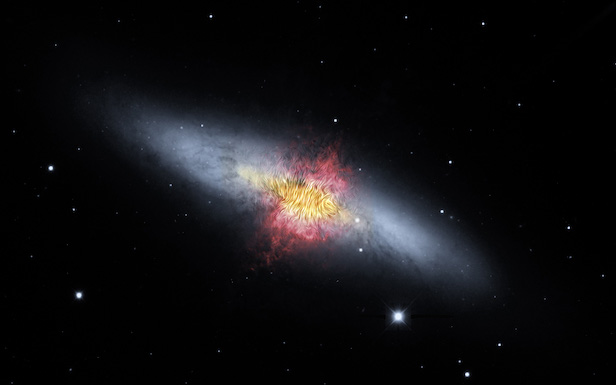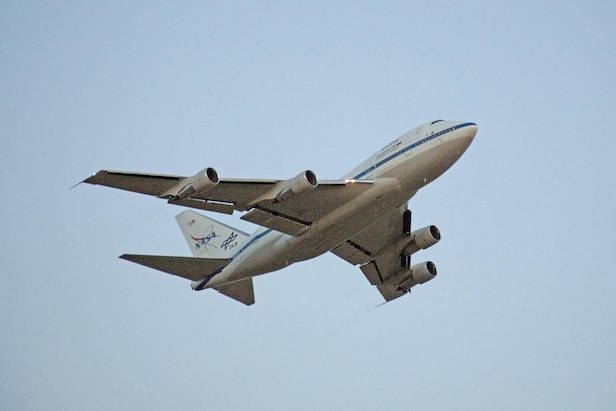Winds and magnetic fields can align to create stars at ridiculous rate
NASA’s airborne observatory has shown how galactic winds and magnetic fields could explain why the Cigar Galaxy is creating stars at an impressive rate

The magnetic field lines of the the Cigar Galaxy appear in this composite image. The lines follow the bipolar outflows (red) generated by exceptionally high rates of star formation. Image credit: NASA/SOFIA/E. Lopez-Rodiguez; NASA/Spitzer/J. Moustakas et al.
The Cigar Galaxy (also known as M82) is famous for its extraordinary speed in making new stars, with stars being born 10 times faster than in the Milky Way. Now, data from the Stratospheric Observatory for Infrared Astronomy, or SOFIA, have been used to study this galaxy in greater detail, revealing how material that affects the evolution of galaxies may get into intergalactic space.
Researchers found, for the first time, that the galactic wind flowing from the centre of the Cigar Galaxy (M82) is aligned along a magnetic field and transports a very large mass of gas and dust – the equivalent mass of 50 million to 60 million Suns.
“The space between galaxies is not empty,” says Enrique Lopez-Rodriguez, a Universities Space Research Association (USRA) scientist working on the SOFIA team. “It contains gas and dust – which are the seed materials for stars and galaxies. Now, we have a better understanding of how this matter escaped from inside galaxies over time.”
Besides being a classic example of a starburst galaxy, which means it is forming an extraordinary number of new stars compared with most other galaxies, M82 also has strong winds blowing gas and dust into intergalactic space. Astronomers have long theorised that these winds would also drag the galaxy’s magnetic field in the same direction, but despite numerous studies, there has been no observational proof of the concept.
Researchers using the airborne observatory SOFIA found definitively that the wind from the Cigar Galaxy not only transports a huge amount of gas and dust into the intergalactic medium, but also drags the magnetic field so it is perpendicular to the galactic disk. In fact, the wind drags the magnetic field more than 2,000 light years across – close to the width of the wind itself.

Ready for take off – SOFIA heads to the stratosphere to observe the universe. Image credit: NASA/Carla Thomas
“One of the main objectives of this research was to evaluate how efficiently the galactic wind can drag along the magnetic field,” says Lopez-Rodriguez. “We did not expect to find the magnetic field to be aligned with the wind over such a large area.”
These observations indicate that the powerful winds associated with the starburst phenomenon could be one of the mechanisms responsible for seeding material and injecting a magnetic field into the nearby intergalactic medium. If similar processes took place in the early universe, they would have affected the fundamental evolution of the first galaxies. The results were published in January 2019 in the Astrophysical Journal Letters.
SOFIA’s newest instrument, the High-resolution Airborne Wideband Camera-Plus, or HAWC+, uses far-infrared light to observe celestial dust grains, which align along magnetic field lines. From these results, astronomers can infer the shape and direction of the otherwise invisible magnetic field. Far-infrared light provides key information about magnetic fields because the signal is clean and not contaminated by emission from other physical mechanisms, such as scattered visible light.
“Studying intergalactic magnetic fields – and learning how they evolve – is key to understanding how galaxies evolved over the history of the universe,” says Terry Jones, professor emeritus at the University of Minnesota, in Minneapolis, and lead researcher for this study. “With SOFIA’s HAWC+ instrument, we now have a new perspective on these magnetic fields.”
Keep up to date with the latest news in All About Space – available every month for just £4.99. Alternatively you can subscribe here for a fraction of the price!




